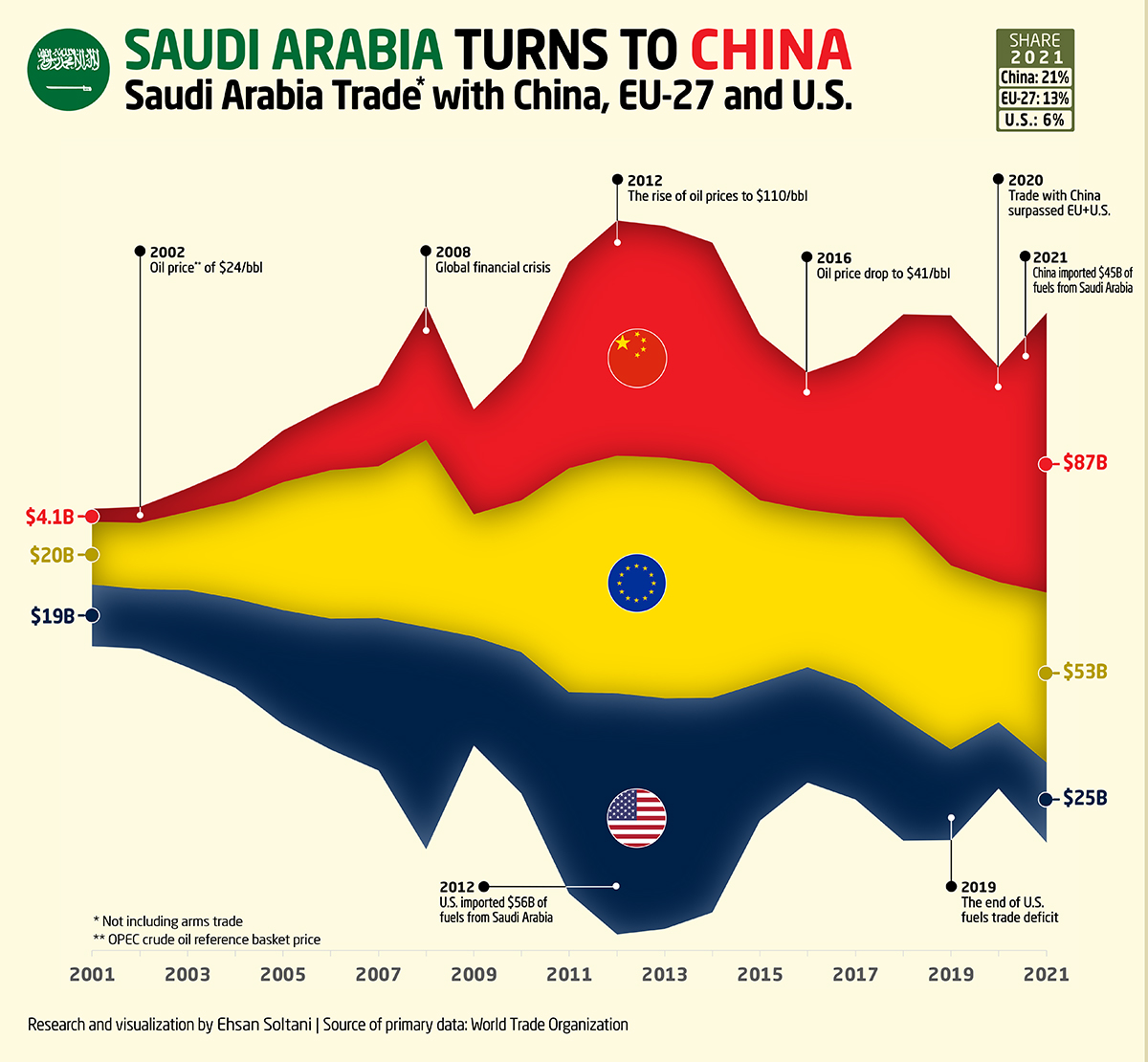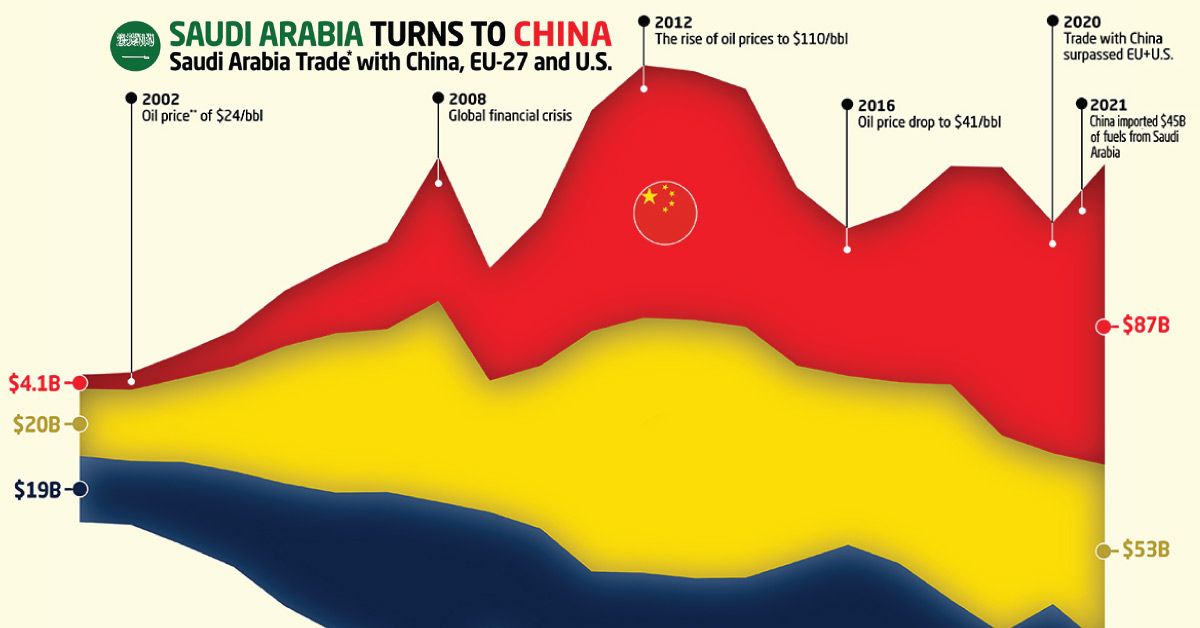Markets
How China Became Saudi Arabia’s Largest Trading Partner

Saudi Arabia’s Trade With China Surpasses the West
Over the past two decades, the economic presence of China has been growing significantly around the world.
The country has already surpassed the U.S. as the largest trading partner of developed nations such as Japan and the European Union.
But the world’s second largest economy is making significant inroads in the Middle East as well. This graphic by Ehsan Soltani uses data from the World Trade Organization (WTO) to chart Saudi Arabia’s trading history with the EU, the U.S, and China.
Evolving Trade Relations
With China’s imports from and exports to Saudi Arabia now exceeding the major oil-producing country’s combined trade with the U.S. and the EU, China has become Saudi Arabia’s dominant trading partner.
| Saudi Arabia Net Trade by Year | With China ($B) | With U.S. ($B) | With EU-27 ($B) |
|---|---|---|---|
| 2021 | $87.3B | $25.1B | $53.1B |
| 2020 | $67.2B | $20.6B | $43.8B |
| 2019 | $78.1B | $28.3B | $57.4B |
| 2018 | $63.5B | $38.2B | $62.7B |
| 2017 | $50.1B | $36.0B | $52.6B |
| 2016 | $42.9B | $36.0B | $49.1B |
| 2015 | $51.8B | $43.2B | $56.9B |
| 2014 | $69.1B | $67.1B | $73.0B |
| 2013 | $72.2B | $72.1B | $75.2B |
| 2012 | $73.3B | $75.3B | $74.3B |
| 2011 | $64.3B | $62.7B | $70.0B |
| 2010 | $43.2B | $44.1B | $47.4B |
| 2009 | $32.6B | $34.0B | $38.2B |
| 2008 | $41.8B | $69.5B | $58.4B |
| 2007 | $25.4B | $47.6B | $47.3B |
| 2006 | $20.1B | $40.9B | $46.2B |
| 2005 | $16.1B | $35.7B | $39.9B |
| 2004 | $10.3B | $27.8B | $30.5B |
| 2003 | $7.3B | $24.1B | $24.4B |
| 2002 | $5.1B | $18.7B | $20.5B |
| 2001 | $4.1B | $19.2B | $19.6B |
Back in 2001, Saudi Arabia’s trade with China was a mere fraction—just one-tenth—of its combined trade with the EU and United States. While the total value of trade was modest at this time, it’s been increasing consistently almost every year since.
By the year 2011, China had surpassed the U.S. for the first time in bilateral trade value with Saudi Arabia. Then by 2018, trade between China and Saudi Arabia surpassed the Middle-Eastern country’s trade with the entire EU.
Fast forward to today, and China has emerged as a larger trading partner with Saudi Arabia than the rest of the West combined.
The Perfect Match?
China’s status as Saudi Arabia’s biggest trading partner makes sense considering its recent economic growth and focus.
China is the largest buyer of crude oil in the world, and it buys more from the Saudi Arabia than anywhere else. Almost half of the $87.3 billion bilateral trade between the two nations in 2021 was comprised of China’s crude oil imports. This accounted for 77% of China’s total imports from Saudi Arabia, which also included goods like plastic—a petroleum product.
Saudi Arabia, meanwhile, imported over $30 billion worth of goods including technological equipment, telephones, and light fixtures.

This article was published as a part of Visual Capitalist's Creator Program, which features data-driven visuals from some of our favorite Creators around the world.
Economy
Economic Growth Forecasts for G7 and BRICS Countries in 2024
The IMF has released its economic growth forecasts for 2024. How do the G7 and BRICS countries compare?

G7 & BRICS Real GDP Growth Forecasts for 2024
The International Monetary Fund’s (IMF) has released its real gross domestic product (GDP) growth forecasts for 2024, and while global growth is projected to stay steady at 3.2%, various major nations are seeing declining forecasts.
This chart visualizes the 2024 real GDP growth forecasts using data from the IMF’s 2024 World Economic Outlook for G7 and BRICS member nations along with Saudi Arabia, which is still considering an invitation to join the bloc.
Get the Key Insights of the IMF’s World Economic Outlook
Want a visual breakdown of the insights from the IMF’s 2024 World Economic Outlook report?
This visual is part of a special dispatch of the key takeaways exclusively for VC+ members.
Get the full dispatch of charts by signing up to VC+.
Mixed Economic Growth Prospects for Major Nations in 2024
Economic growth projections by the IMF for major nations are mixed, with the majority of G7 and BRICS countries forecasted to have slower growth in 2024 compared to 2023.
Only three BRICS-invited or member countries, Saudi Arabia, the UAE, and South Africa, have higher projected real GDP growth rates in 2024 than last year.
| Group | Country | Real GDP Growth (2023) | Real GDP Growth (2024P) |
|---|---|---|---|
| G7 | 🇺🇸 U.S. | 2.5% | 2.7% |
| G7 | 🇨🇦 Canada | 1.1% | 1.2% |
| G7 | 🇯🇵 Japan | 1.9% | 0.9% |
| G7 | 🇫🇷 France | 0.9% | 0.7% |
| G7 | 🇮🇹 Italy | 0.9% | 0.7% |
| G7 | 🇬🇧 UK | 0.1% | 0.5% |
| G7 | 🇩🇪 Germany | -0.3% | 0.2% |
| BRICS | 🇮🇳 India | 7.8% | 6.8% |
| BRICS | 🇨🇳 China | 5.2% | 4.6% |
| BRICS | 🇦🇪 UAE | 3.4% | 3.5% |
| BRICS | 🇮🇷 Iran | 4.7% | 3.3% |
| BRICS | 🇷🇺 Russia | 3.6% | 3.2% |
| BRICS | 🇪🇬 Egypt | 3.8% | 3.0% |
| BRICS-invited | 🇸🇦 Saudi Arabia | -0.8% | 2.6% |
| BRICS | 🇧🇷 Brazil | 2.9% | 2.2% |
| BRICS | 🇿🇦 South Africa | 0.6% | 0.9% |
| BRICS | 🇪🇹 Ethiopia | 7.2% | 6.2% |
| 🌍 World | 3.2% | 3.2% |
China and India are forecasted to maintain relatively high growth rates in 2024 at 4.6% and 6.8% respectively, but compared to the previous year, China is growing 0.6 percentage points slower while India is an entire percentage point slower.
On the other hand, four G7 nations are set to grow faster than last year, which includes Germany making its comeback from its negative real GDP growth of -0.3% in 2023.
Faster Growth for BRICS than G7 Nations
Despite mostly lower growth forecasts in 2024 compared to 2023, BRICS nations still have a significantly higher average growth forecast at 3.6% compared to the G7 average of 1%.
While the G7 countries’ combined GDP is around $15 trillion greater than the BRICS nations, with continued higher growth rates and the potential to add more members, BRICS looks likely to overtake the G7 in economic size within two decades.
BRICS Expansion Stutters Before October 2024 Summit
BRICS’ recent expansion has stuttered slightly, as Argentina’s newly-elected president Javier Milei declined its invitation and Saudi Arabia clarified that the country is still considering its invitation and has not joined BRICS yet.
Even with these initial growing pains, South Africa’s Foreign Minister Naledi Pandor told reporters in February that 34 different countries have submitted applications to join the growing BRICS bloc.
Any changes to the group are likely to be announced leading up to or at the 2024 BRICS summit which takes place October 22-24 in Kazan, Russia.
Get the Full Analysis of the IMF’s Outlook on VC+
This visual is part of an exclusive special dispatch for VC+ members which breaks down the key takeaways from the IMF’s 2024 World Economic Outlook.
For the full set of charts and analysis, sign up for VC+.
-

 Markets1 week ago
Markets1 week agoU.S. Debt Interest Payments Reach $1 Trillion
-

 Markets2 weeks ago
Markets2 weeks agoRanked: The Most Valuable Housing Markets in America
-

 Money2 weeks ago
Money2 weeks agoWhich States Have the Highest Minimum Wage in America?
-

 AI2 weeks ago
AI2 weeks agoRanked: Semiconductor Companies by Industry Revenue Share
-

 Markets2 weeks ago
Markets2 weeks agoRanked: The World’s Top Flight Routes, by Revenue
-

 Countries2 weeks ago
Countries2 weeks agoPopulation Projections: The World’s 6 Largest Countries in 2075
-

 Markets2 weeks ago
Markets2 weeks agoThe Top 10 States by Real GDP Growth in 2023
-

 Money2 weeks ago
Money2 weeks agoThe Smallest Gender Wage Gaps in OECD Countries















